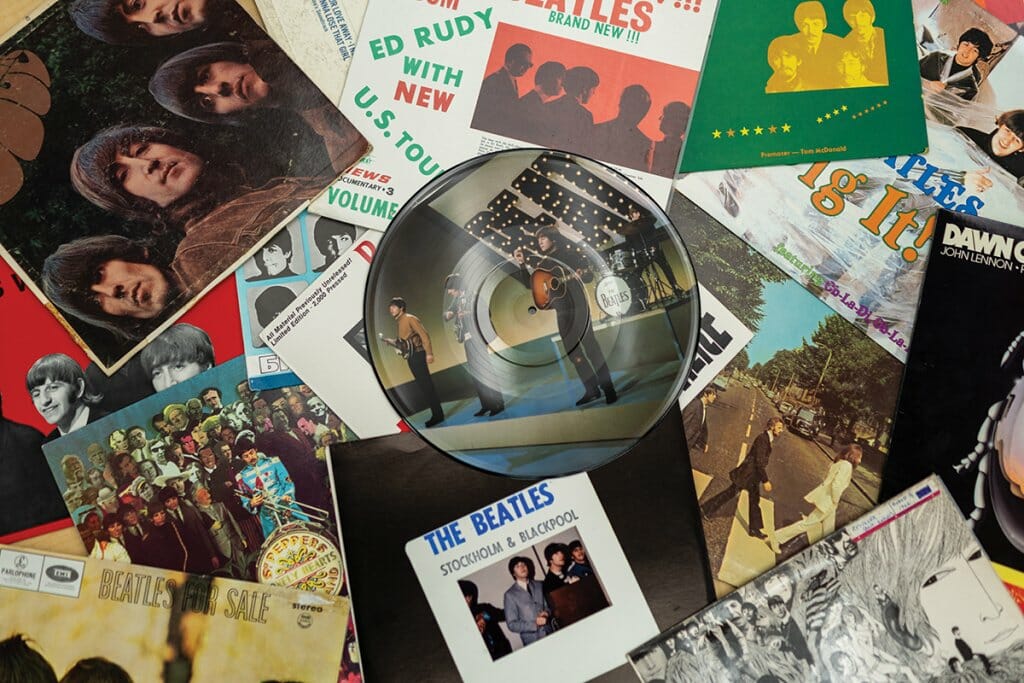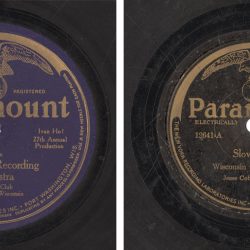She Loves U-Rah-Rah (Rah)
The Beatles finally make it to Madison, thanks to a new collection in Mills Music Library.

The treasure trove of vinyl and memorabilia comprises more than 600 rare LPs featuring live shows, interviews, press conferences, home recordings, outtakes, and unreleased tracks. Chris Flink
Throughout their brief but busy touring years, the Beatles never touched down on a Madison tarmac. Neither the unmistakable opening chord of “A Hard Day’s Night” nor the frenzied shrieks that drowned out the band’s live concerts ever rattled the rafters of the Stock Pavilion or echoed through the stately halls of Memorial Union. More than 50 years after the Fab Four broke up, they have finally found their way to the UW–Madison campus — not on a stage, but in the rare kind of library where sound abounds.
The Jim Berkenstadt Beatles LP Collection, the latest addition to the Mills Music Library, isn’t your local record store’s stock of the band’s biggest hits. Instead, this treasure trove of vinyl and memorabilia explores the nuances of some of the most influential musicians in history through bootleg recordings of the band and of the individual members in their solo careers. It comprises more than 600 rare LPs featuring live shows, interviews, press conferences, home recordings, outtakes, unreleased tracks, and more.
“I took classes in art in college, and we would follow a Picasso from its very first drawings all the way to the finished painting,” says Berkenstadt, the curator and donor of the collection. “[Through these bootlegs], I was looking at the Beatles’ music in that same way.”
Berkenstadt is a music historian who has made a name for himself as the “Rock and Roll Detective.” In addition to publishing numerous best-selling books, he has consulted on such projects as Martin Scorsese’s George Harrison: Living in the Material World (2011), Ron Howard’s The Beatles: Eight Days a Week — The Touring Years (2016), and Peter Jackson’s The Beatles: Get Back (2021).
The beauty of the collection lies not only in the novelty of its items, but in their utility for teaching the history of recorded sound through a band that was instrumental in shaping it.
“The Beatles were issued in lots of different configurations, so we can study how those recording technologies actually impacted the sound,” says Nate Gibson, an ethnomusicologist and audiovisual preservation archivist at Mills. Music public services librarian Tom Caw also sees the collection as a tool for teaching students about the unique attributes of vinyl, such as liner notes and cover art.
“I’m excited about having the physical evidence to share with students so that they get the fuller sense of what these LPs meant in their time: for us to hold them in our hands, to look at them, to turn from the front cover to the back cover, and then to take the LP out and play it on our equipment,” says Susan Cook, director of the UW Mead Witter School of Music. “It [shows] that the music isn’t just the sound. The music is the technology. The music is the material culture.”
Published in the Winter 2022 issue



Comments
Jeff Norman (BA'84) November 27, 2022
Liner notes and cover art are not “unique attributes of vinyl.” CDs often have liner notes and always have cover art.
Even downloads generally come with cover art–and it’s been a lost opportunity not to include extensive notes and artwork alongside downloads in the form of PDFs. In fact, a download has potential to include cover art and notes at scales vinyl can’t hope to compare with, since the size of notes and artwork is not limited by a physical format.